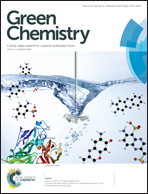Solvent-free mechanochemical synthesis of alane, AlH3: effect of pressure on the reaction pathway†
Abstract
Nearly quantitative mechanochemical synthesis of non-solvated AlH3 from lithium aluminium hydride (LiAlH4) and aluminium chloride (AlCl3) has been achieved at room temperature under reasonably low pressure of hydrogen (210 bar) or inert gas (125 bar for He or 90 bar for Ar). X-ray diffraction, solid-state 27Al NMR spectroscopy, and temperature programmed desorption analyses of as-milled materials reveal a nearly complete conversion of a 3 : 1 (molar) mixture of LiAlH4 and AlCl3 to a 4 : 3 (molar) mixture of AlH3 and LiCl in ca. 30 min. By applying pressure of 210 bar or less (depending on the gas: hydrogen, helium, or argon), competing reactions leading to formation of metallic aluminium can be completely suppressed. X-ray diffraction and NMR analyses of products extracted at various stages of the mechanochemical reaction between LiAlH4 and AlCl3 reveal, for the first time, that the solid-state transformation proceeds with LiAlCl4 as an intermediate. Evidently, the critical pressure required to suppress the formation of metallic aluminium depends on the rate at which mechanical energy is supplied during milling. For example, the critical pressure is reduced from 210 bar to 1 bar of hydrogen when the milling speed of a standard planetary mill is reduced from 300 rpm to 150 rpm, although at the expense of sluggish kinetics and much longer reaction time.


 Please wait while we load your content...
Please wait while we load your content...